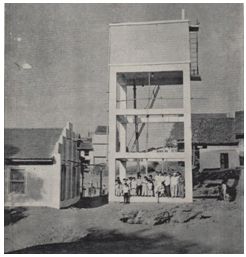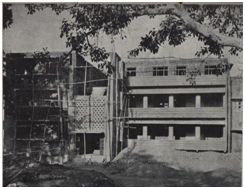Our History
Manubar is a village with the population of over 7000, and located west of Bharuch city. Its original name was Munawwar, but due to slang vocabulary in daily conversation changed it to present day Manubar.
The village is divided in two parts; Thobhag vago and Chakla vago. Two brothers from Dhorka and Dhandhuka came and settled here, and over the years their population grew and became present day Manubar. People of Dhorka and Dhandhuka live the same culture and social life as Manubar.

First water tank was built in 1965 |
Gypsies used to pass through the village; this is evident from the deep well in the main foregrounds, which had steps to climb down the well to obtain water. Foregrounds had two big communal places where Gypsies used to rest, in front of these foregrounds, there were two Todlas.
Boys primary school was located in the foregrounds; Haji Ahmed Munshi was the head teacher at the time. Girls primary school was run from the Jamal house in the village; Raja Master was its head teacher. Kadva Master, Kaba Master, Vanka Master and from vahalu Yusuf Ashrafi, who was also a poet where teaching in the schools. During this time pupil numbers were small due to the small village population at the time. |
Vahora Patels from the village were capable in all aspects of life. They travelled to other cities and towns to earn their living through small businesses, which they still actively carried that tradition to present day. There were others who kept themselves occupied in village farming.
There were many teachers in the village, from which Hajibapu, Alibhai Meriwala, Audhiya Munshi were well known for their teaching profession, and were teaching in Bharuch city.
Audhiya Munashi family had many teachers, including Ismail Master & his wife, Musa Master & his wife. Alibhai Neriwala & his wife Huriben. They were at the forefront in teaching. There were other teachers from the village, who taught in other villages, cities and towns. Furthermore, Musa Desai, Muhammad Collector and Ahmed Kothiya served as teachers in Khozakhan in Mumbai Dungri.
Likes of Alibhai Maji Patel, Abhram Valli (Sarpanch), Mirzadada, Muhammad Manudada, Asmaldada Sufi, Alibhai Kathiawadi, Audhiya Sulemandada, Gatidada, Alibhai Chimtadada, Biramdada, Umraji Validada & Son Alibhai Umarji Vali, Barvatiyadada, Khanjradada were well known in the village for their intelligence, piety and wisdom.
People like Muhammad Amdawadi, Ahmedbhai Amdawadi, Musa Dasai went to Mumbai, Ahmadabad, Bharuch and Baroda, where they contributed their services in the Post office, entertainment, courts, jails and various government fields, and made Manubar known on the map of India.
In the education field; Munshi Family and Biram Family played major role in the village. Maulana Adam and his brother Maulana Ismail were the successive founders of the Kantharia Darul-uloom. Thus, helping in creating a deeni environment in the district.
In the new breeds, we have likes of Mohammed Maji Patel, Mohammed Sufi, Hafej Ibrahim Badin, Mohammed Badamiya, Mohammed Anga, Mohammed Bhaja, Dawood Ali Kathiyawadi, Ismail Abram Valli (Sarpanch) and many more, who contributed in the reporting, poerty, welfare, education and politics.
The present day Girls primary school was for boys initially. There were about five or six teachers serving the school, and there was an additional class in the village.
English education was hard to achieve due to travel by foot to Bharuch. There were four English medium schools in the city, which included government, Pioneer, Progressive and union. Students from Manubar and Karmad would walk for three miles to arrive at Bharuch for 11 o clock via Pipda and Varalia.
These schools would facilitate students from Hindu, Muslim, Parsi and other religious backgrounds. Sahitya, Maths, Algebra, Persian Grammar taught in English. Teachers were very intellectual and focused in teaching these subjects, and the likes of Musa Master Ikhar, Kesri Master, Sayyad Master. Pujalal Patel from Suri Samni, Vaid Saheb, Trivedi Saheb from Bharuch, Parsi Bawaji spearheaded these challenges.
Science writer C. C. Seth himself taught in Pioneer school. Jetley Saheb was Principle for Progressive School.
Through these great teachers Manubar produced great personalities like Janab Ismail Somal Patel, who is a retired scientist now living in Canada. Sufi Manubari, a world famous poet and now living in the U.K. Mohammed Ahmed Munshi and brothers, who contributed their wealth for religious, educational and welfare causes. Janab Ibrahim Biram, who was a great visionary educated at Aligargh university and Mufi Inayatullah Gurji, who has dedicated his life for the betterment of the humanity in the time of great corruption and vices. These are just the few out of many hundreds.

1965 Construction of Naqib-ul-Islam Madrasa |
Ulamas and Huffaz were many in numbers in the village, these included Khepi family, which had eight to nine individuals, and in particular Maulana Valiullah, Maulana Ibrahim and his brother Maulana Muhammed, Maulana Dawood and his brother Maulana Musa etc were passionately involved in creating Deeni environment in the village. Furthermore, Ibrahim Hafeji Sufi and Musa Master Molvi were in the list. They received their Deeni education from Rander, Kantharia, Dabhel, Talkeshwer, Jalalabad, Deuband etc. |
Kazi Saabs was a familiar name in the village. For three generations this family has served as Imams and Madrasa ustads. Last Kazi Saab earned his hifz title from Kantharia Darul-uloom. Before them there were only two ustads in the village, one of them was Maulana Valiullah from the place called Hazara in Panjab district and the other one was Abdulrehman from the village. As time passed, a Qari Saab from the Tonk town in Rajasthan, Maulana Adam and Rehman from Ikhsar served as ustads in the Madrasa.

1966 Jamia Masjid Entrance |
Newly crowned Huffaz recited Quran during the month of Ramadan in beautiful melodious tone and voice. Following had the honour of reciting; Ali Hafez Vadva, Hafez Ismail Gati, Hafez Matadar, Hafez Suleman Khanjra, Hafez Munshi Gisa and Hafez Yusuf Chuniya. |
Village had Tannery facilities, where Mochi community used to treat leather, and learned their skills from Sayyad, who was living in Manubar at the time. Lalu, Dudhya, Mangal etc from the community travelled to various places to utilise their skill in making shoes and slippers.
The famous scientist Mr Ismail Patel Somal learnt how to treat fish skin in Bandra, Mumbai and this earned him appointment as a government official in Madras, India. He now lives in Toronto, Canada, where he is heavily involved in serving the community.
The village had three enclaves; Khalpawaad, Bhilwaad and Dherwaad. Potters and Barbers were living in and around these enclaves. People living in these enclaves worked for Patels in the village for yearly return of wheat, barley, cotton, pulses and even cash. This tradition ran for many years, and is still continuing to this day. These people were fond of musical instruments. When fire broke out, Harijans used to warn people by blowing Kakar Singi. During the time of happiness and weddings, Himjaan, Lalvo and Keshyio (folk singers) would play Dhanush in front of the wedding precessions. They also played Dhaturu and Vajintry.
The Potter made, pots called Matla, Batera and Chadwa People would use Matla (container) and Batera to keep Dal Gosh (Meat Curry) in the wedding ceremony, and used Chadwa for water.
There were two well known Barbers called Ranchhod and Ichheymota, both shared the village in half for cutting hair and trimming beard etc. Every Thursday and Friday both would seat on the forecourts of their dwellings with cutting instruments, people would queue to get their hair cut. They would ask small boys to go and wash the head in the near by Talav (reservoir) before shaving the head.
There are around nineteen streets in the village; every street was named after a name of an individual or a family, i.e. Sethani Street, Patel Street, Gudawala Street, Wadwa Street and Khepi Street etc. Many people also prefer the life in farm just outside the village.

1965 Maids with balancing clay water containers |
There were four deep water wells around the village. People used to pull out water for drinking, bathing and washing. During the night of a full moon, the sight of water fillers (maids) walking with big water pots on their heads without a support was one to watch.
Boys from village would get together on the night of the full moon to play games such as; Kabaddi, Gali Dundo, Marble game, Ambda Peepdi, Gokhyam Gokhya, Chhap Bander, AntKari and Bhamardi. As time went on, cricket took the centre stage, which is still being played as the main sport.
There were two huge Pipda tree located on the way between Manubar and Karmad, and would shelter over 300 night birds, who would fill the night with their singing sound, other huge Pipda was on the banks of Talav (reservoir) near the Desai house, which sheltered red beak parrots, who would eat red fruit from the same tree as their diet. |
As time went on, village population grew, and old dying generation required burial spots, which eventually turned into fifteen cemeteries (Kabrastans).
Many thanks to Late Janab Haji Muhammad Sufi Saheb for providing the history....
OUR VIEWERS ARE REQUESTED TO SEND MORE VILLAGE HISTORY AND PICTURES TO
info@ourmanubar.com